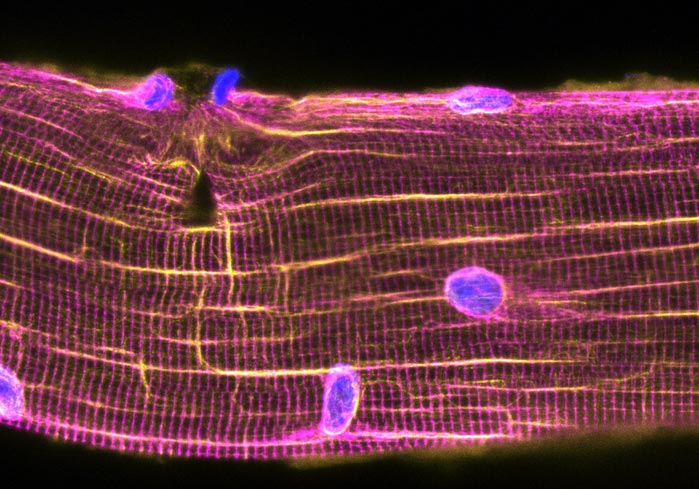Nuclei on the move for muscle self-repair

The microtubule network (green) re-organizes at the muscle lesion and attracts myonuclei.
Crédits: William Roman, iMM
Muscle is known to regenerate through a complex process that involves several steps and depends on stem cells. Now, a new study led by researchers at the Instituto de Medicina Molecular João Lobo Antunes (iMM; Portugal) and the University Pompeu Fabra (UPF Barcelona; Spain) and published today in the scientific journal Science describes a new mechanism for muscle regeneration after physiological damage relying on the rearrangement of nuclei. This protective mechanism opens the road to a broader understanding of muscle repair in physiology and disease.
Skeletal muscle tissue, the organ responsible for locomotion, is formed by cells that have more than one nucleus, an almost unique feature in our body. Despite the plasticity of muscle cells, their contraction can be accompanied by muscle damage. William Roman, main author of the study and researcher at iMM and UPF Barcelona, explains: “Even in physiological conditions, regeneration is vital for muscle to endure the mechanical stress of contraction, which often leads to cellular damage.” Although muscle regeneration has been deeply investigated in the past decades, most studies were centered on mechanisms involving other cells, including muscle stem cells, which are required upon extensive muscle damage.
“In this study we found an alternative mechanism of regeneration that is muscle cell autonomous”, says Pura Muñoz-Cánoves, group leader at the University Pompeu Fabra, and study leader. Researchers used different in vitro models of injury and models of exercise in mice and humans to observe that upon injury, nuclei are attracted to the damage site, accelerating the repair of the contractile units. Next, the team dissected the molecular mechanism of this observation: “Our experiments with muscle cells in the laboratory showed that the movement of nuclei to injury sites resulted in local delivery of mRNA molecules. These mRNA molecules are translated into proteins at the site of injury to act as building blocks for muscle repair”, explains William Roman. On the importance of these discoveries, Pura Muñoz-Cánoves says: “This finding constitutes an important advance in the understanding of muscle biology, in physiology and muscle dysfunction.”
In addition to its implications for muscle research, this study also introduces more general concepts for cell biology, such as the nuclear movement to injury sites. “One of the most fascinating things in these cells is the movement during development of their nuclei, the biggest organelles inside the cell, but the reasons why nuclei move are largely unknown. Now, we showed a functional relevance for this phenomenon in adulthood during cellular repair and regeneration”, says Edgar R. Gomes, group leader at the Instituto de Medicina Molecular and Professor at Faculdade de Medicina da Universidade de Lisboa, who co-led the study.
The work was developed at iMM and UPF Barcelona in collaboration with the University of Valencia. This study was funded by the Association Française contre les Myopathies, the European Molecular Biology Organization, the Human Frontiers Science Program, MINECO-Spain and the European Research Council.
More information:
Instituto de Medicina Molecular (iMM; Portugal)
The iMM – Instituto de Medicina Molecular João Lobo Antunes is a leading Portuguese private non-profit research institute that offers a vibrant scientific environment, aiming to nurture innovative ideas in basic, clinical and translational biomedical research.
University Pompeu Fabra (Barcelona; Spain)
The UPF (and the CEXS Department in particular) and CNIC are two centers of excellence (María de Maeztu and Severo Ochoa respectively) devoted to Biomedicine and Cardiovascular research.
Journal: Science
DOI: 10.1126/science.abe5620
Method of Research: Experimental study
Subject of Research: Cells
Article Title: Muscle repair after physiological damage relies on nuclear migration for cellular reconstruction
Article Publication Date: 15-Oct-2021
All latest news from the category: Life Sciences and Chemistry
Articles and reports from the Life Sciences and chemistry area deal with applied and basic research into modern biology, chemistry and human medicine.
Valuable information can be found on a range of life sciences fields including bacteriology, biochemistry, bionics, bioinformatics, biophysics, biotechnology, genetics, geobotany, human biology, marine biology, microbiology, molecular biology, cellular biology, zoology, bioinorganic chemistry, microchemistry and environmental chemistry.
Newest articles

Silicon Carbide Innovation Alliance to drive industrial-scale semiconductor work
Known for its ability to withstand extreme environments and high voltages, silicon carbide (SiC) is a semiconducting material made up of silicon and carbon atoms arranged into crystals that is…

New SPECT/CT technique shows impressive biomarker identification
…offers increased access for prostate cancer patients. A novel SPECT/CT acquisition method can accurately detect radiopharmaceutical biodistribution in a convenient manner for prostate cancer patients, opening the door for more…

How 3D printers can give robots a soft touch
Soft skin coverings and touch sensors have emerged as a promising feature for robots that are both safer and more intuitive for human interaction, but they are expensive and difficult…





















